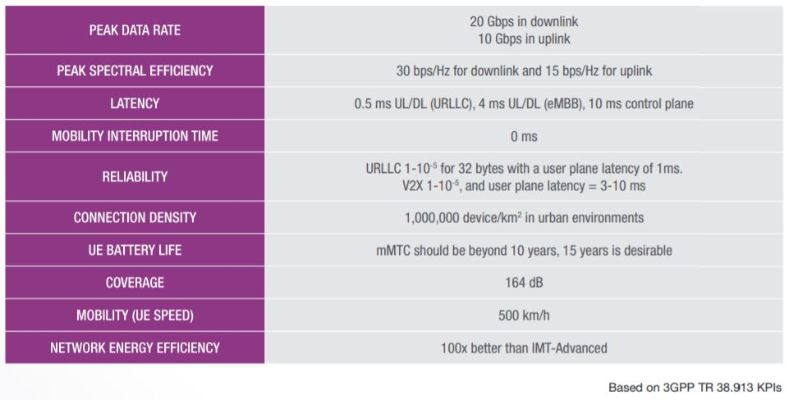
A Blueprint to 5G New Radio Standards
As 5G accelerates to commercialization, how do designers know the requirements for device and base station designs?
Chipsets and devices will operate at higher frequencies with wider transmission bandwidths. Devices and base stations will use new access technologies to make connections, and networks will evolve to handle more data, more users, and different levels of service. 4G and 5G New Radio (NR) networks must work in harmony to provide seamless service for users.
The 5G NR Third Generation Partnership Project (3GPP) standards represent the blueprints for making 5G work. Here are 5 tips to help you understand the 5G NR standards.
1. Understand 5G NR Use Cases and their Key Performance Indicators (KPI)
The 5G vision identifies three primary use cases that will bring about disruptive change and fuel the development of new applications and new business models.
- Enhanced mobile broadband (eMBB) is about very high throughput rates to support applications like UHD streaming or virtual reality.
- Ultra reliable low latency (URLLC) promises low latency interfaces with very high reliability for mission critical applications like drones or driverless automobiles.
- Massive machine type communications (mMTC) enables millions of devices communicating incorporating low data rates, less energy and lower costs. Think smart cities.
3GPP study item TR 38.913 describes the KPIs for the different deployment scenarios (eMBB, URLLC, mMTC), as well as vehicle-to-everything (V2X) requirements. KPIs include target peak data rates, spectral efficiency, latency, reliability, UE battery life, and more:

2. Be Aware of What Is Coming Next and When
5G NR Release-15 was approved in June 2018 but the work continues. Conformance test for the many different test cases and network deployment options for Release-15 are still being developed, while work on Release-16 (phase 2) is well underway with an official release planned later this year.
- Phase 1: Release-15 focuses on laying the foundation for eMBB and URLLC use cases. It incorporates 4G LTE, 5G NR Release-15, and the next generation system architecture.
- Phase 2: Continues with 5G NR optimization and introduces new use cases with 5G NR Release-16 planned for the end of 2019. Release-16 identifies new types of services, devices, deployment models and spectrum bands with an emphasis on URLLC enhancements for industrial IoT, utilization of unlicensed bands, V2X, and UE positioning and power efficiency. It is expected that NR Release-15 will be forward compatible with NR Release-16.

3. Know Where to Go for 5G NR Information
5G NR specifications are developed by the RAN (radio access network) working groups. All documents, meeting reports, and published specifications are available on the 3GPP Website. You can find 5G NR documents in the 38.xxx series:
4. Understand 5G NR Oer-The-Air (OTA) Testing Requirements
5G NR adds new operating bands in mmWave spectrum that will require over-the-air (OTA) testing. Many of the low frequency tests will be performed similar to 4G LTE tests in frequency range 1 (FR1: 450 MHz to 6 GHz). Frequency range 2 (FR2: 24.25 to 52.6 GHz) however, requires radiated tests, which means OTA testing is a new challenge with 5G NR. OTA test methods are also used to validate device and base station beam steering functionality in multi-element antenna arrays that are integrated into RFICs at FR1 and FR2. OTA test methods are described in 3GPP conformance test documents.
5. Familiarize Yourself with Required Conformance Tests
Conformance tests ensure a minimum level of performance in UEs and base stations. UE requirements are very extensive to ensure RF transmission and reception, radio access, signaling and demodulation. Base station tests are structured around RF parameters. Conformance tests only provide pass/fail results, offering no indication of how the device will perform when integrated into a wireless communications system. Vendors will test a wider set of parameters early using verification and regression testing to ensure quality and sufficient margins. Operators will also conduct device acceptance tests to evaluate whether a device has adequate performance on a specific network. 5G NR conformance tests are found in the following 3GPP documents:
- Base Stations - TS 38.141-1/-2
- Devices- 5G NR TS 38.521-1/-2/-3/-4, 38.522, 38.533 and 5GS TS 38.508-1/-2, 38.509, 38.523-1/-2/-3
Learn more about the 5G NR standards by downloading the ABCs of 5G New Radio Standards ebook.